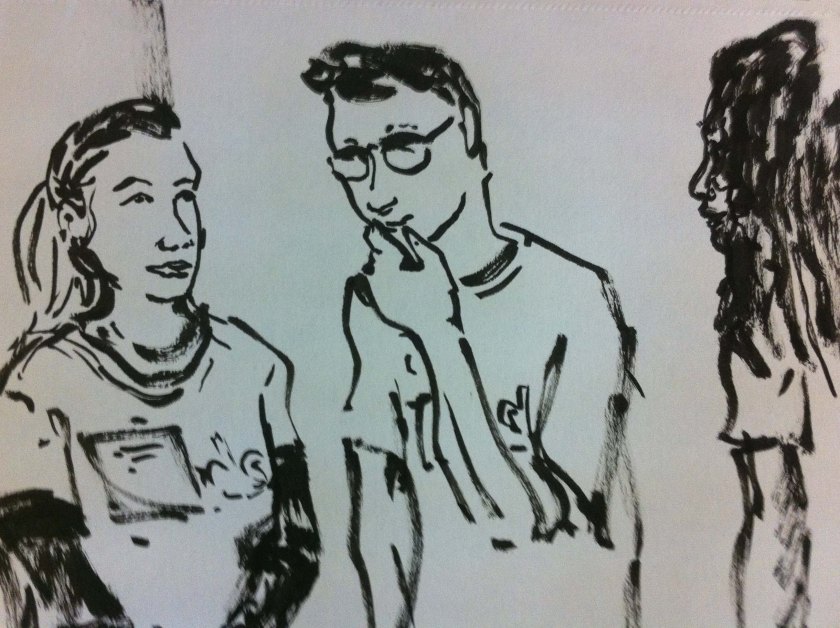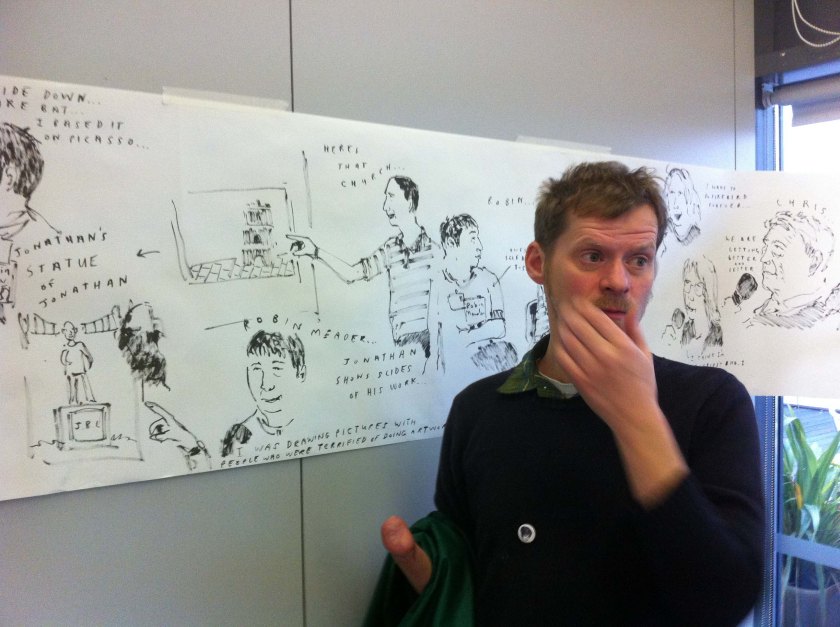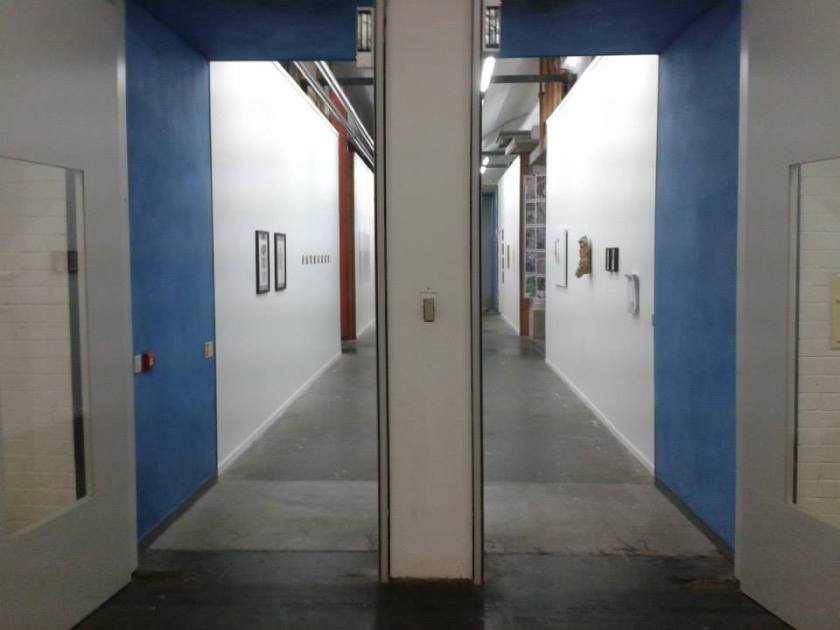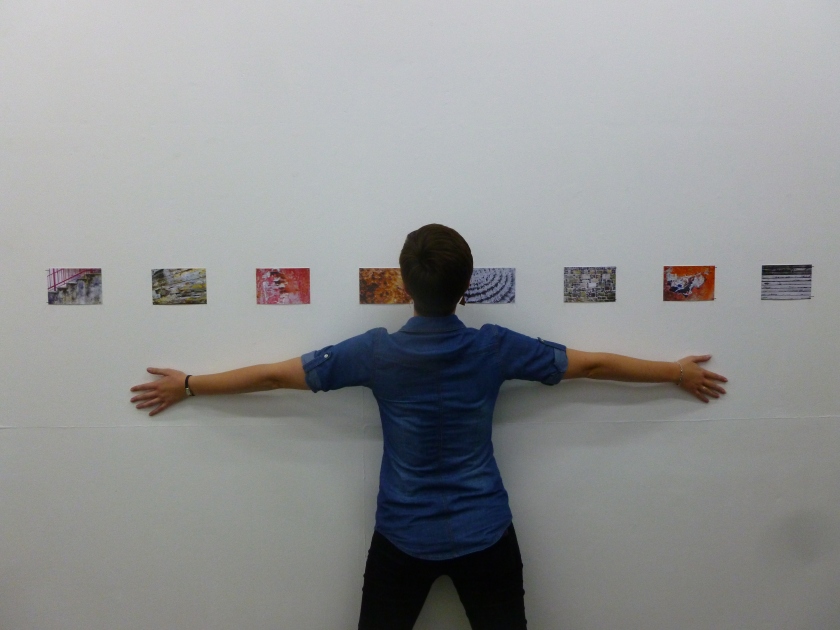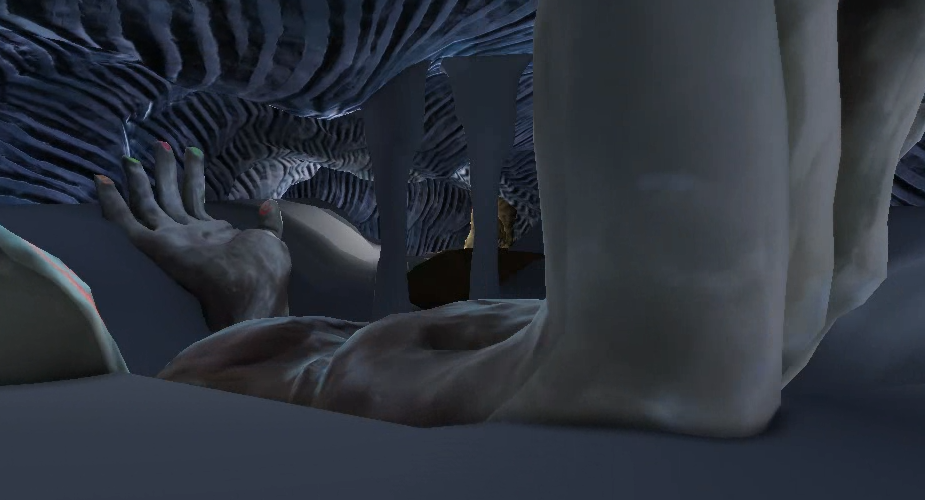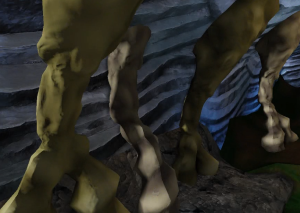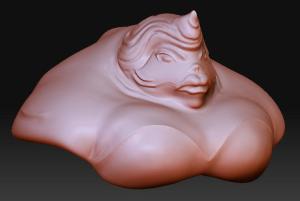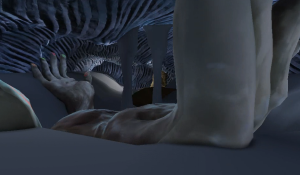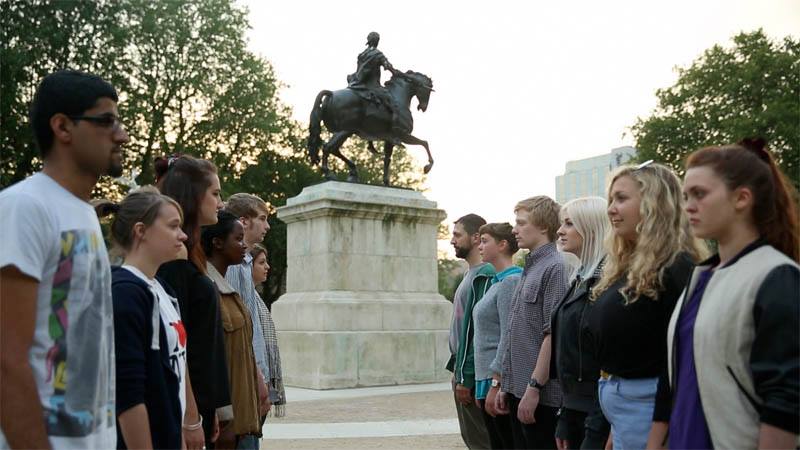I caught up with Jen Howarth just after she’d dropped her work off for an exhibition she’s currently in with Synecdoche Art Collective – a group show by recent graduates and current students of Drawing and Applied Arts at UWE – at the Christmas Steps Gallery. (It’s pronounced si-nek-duh-kee in case you were wondering). In the gallery Jen is exhibiting Jetty [above] (and the original etching print inc. metallic spray paint water is every bit as beautiful in the flesh), while in the Synecdoche pop up shop area Jen has prints, badges and t-shirts for sale. I kind of want to own all of her work.
interview
‘Sub-Doodling’, press ups and Lady Gaga..
Art, Artist, Drawing, Events, Illustrator, Inspirational, Interview, Uncategorized
Cai, Emma and myself recently attended an arts conference at @Bristol, on Disability Led arts hosted by two organisations; the Bristol and Brighton Steering Groups. Designed to inform and inspire the public on disability within the arts today, the conference was attended by people nationwide.
During we met Joff, the events graphic artist who caught our attention right from the start of the day. So, we eventually managed to corner him and fire a few questions his way.
Here is the conversation we had about ‘Sub-Doodling’, press ups and Lady Gaga..
Joff, we thought you would be an incredibly interesting and inspiring person to interview, as Young Arnolfini is all about making art more accessible to young people and today really has opened up our eyes to disability within the arts.
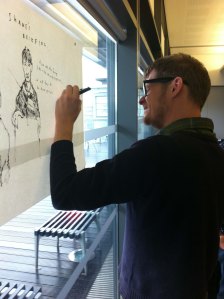 How long have you been drawing?
How long have you been drawing?
I’ve been drawing all time, the whole time.. all my life.
So are you a full time illustrator?
No, I’m not good enough to do that, I can’t draw buildings or vehicles very well!
Oh no, you shouldn’t consider those things as limitations!
Well…. I like doing my press-ups so.. wait what? Sorry what was the question?!
[There’s a lot of laughter at this point as Joff is obviously distracted as he watches people walk by that he could be drawing..]
The question was ‘are you a full time illustrator’?
Ermm I draw a lot of the time, like a lot of the things I do, I do in drawings but I’m not really an illustrator because you have to be able to draw buildings..
There’s no rules to illustration! Can you speak a bit about your work and your style? Do you think you have a particular style?
My style for these kind of events, when I’m documenting things, I’d say is actually quantity not quality! I can do a lot of drawings but a lot of them are pretty bad but as long as I can get the feeling across of what is vaguely going on at the event.
So would you say your style is fast paced and doodle like?
It’s like ‘sub doodle’..
That’s a cool description of it! So do you think that your disability affects you in any ways, positively or negatively?
Ah, that’s a good question.. Er, well maybe it makes people be a bit nicer to me! They’re more forgiving of the not very good likenesses in my drawings! Erm, I don’t know.. well, no.. I don’t know! Sometimes I’m probably a bit more messy than I would be, you know, like if I’ve got a big pile of paper, maybe I’ll drop a few more sheets than someone with a normal hand.. When I’m doing my press ups I have to put a book under my stump to make it the right height!
Do you think anyone can draw?
YES! Definitely..
Do you think everyone should draw?
Yes as well! Definitely!
Do you think thats part of where your practice comes from? From drawing everything, you just get better and better at documenting?
Yes, I love it when other people draw! In fact, Sarah did one of the drawings today, I got her to do it because I got bored of it..
What advise would you give a young person with a disability who would like to go into the arts? Especially drawing, as we have been watching you all day and you have such confidence to just approach people and start drawing them.
Just draw. I know some of these people here, mainly because I’m a huge fan of their work.. I’m a huge fan but not really into contemporary art so much.. but I just really love people who draw! I don’t really know what I’m talking about.. Some people do really realistic, detailed pencils drawings of Lady Gaga.. what am I talking about, I don’t know..
You’re talking about really realistic, detailed pencil drawings of Lady Gaga to an illustrator who does detailed pencil drawings and portraits! Cai has actually drawn Lady Gaga..
Have you?! It’s like two ends of the same string linking up! I can’t draw Lady Gaga.. I can draw a meat dress but I can’t draw the face.. Sorry Cai!
If you could give your 16 year old self a piece of advise, what would it be?
Be nice to your mum. No I was quite nice to my mum.. I’d say don’t talk as much! Id say that to myself now too!
Have you ever experienced any discrimination?
What because I’ve got like one hand? You mean?
Yeah.
Er nah not really.. people are nice!
People are nice to me a lot too, I think it’s my height! I’m short and I think people pity me!
Oh yeah you are quite short!
We really loved all the illustrations Joff created, and below are only a selection of all the ones he created. There were so many, it was hard to choose! Take a look:
Thanks for reading,
Becky
“Exchange” – A review
Art, Artist, Arts, Bristol, Events, Exhibition, Inspirational, LaunchWhat do Spike Island’s volunteers do when they aren’t volunteering?
They create an exhibition of course.
So the other night, I headed up to Spike Island’s test space to check out the exhibition run by and created by some of Spike Island’s volunteers.
There was activity in the air as soon as I entered, and as I turned to walk into the Test Space, I was greeted by a wall of people. Wading through the unfamiliar and familiar faces, I began my experience at “Exchange”.
The exhibition aimed to “explore the exchange between volunteers, art institutions and the public” by demonstrating the “breadth and depth of talent and the variety of artistic interests that come together within the group”; and I feel it managed to do just that.
The work exhibited was varying and showcased a wide variety of talent. It included a range of pieces from photography to sculpture to performance artwork, and even more.
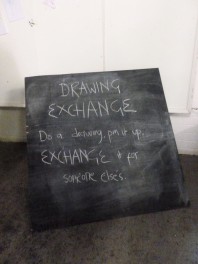 One of the best features of the exhibition had to be its interaction with its visitors. One of the ideas that the curators had was to create a physical “exchange” of ideas there. There was a corner dedicated to this idea where visitors were encouraged to create drawings and pin them to the wall, then to take another in exchange.
One of the best features of the exhibition had to be its interaction with its visitors. One of the ideas that the curators had was to create a physical “exchange” of ideas there. There was a corner dedicated to this idea where visitors were encouraged to create drawings and pin them to the wall, then to take another in exchange.
I feel this worked really well and you could see that the wall was busy with people pinning their own drawings up. By the end of the evening, the contents of the wall had completely changed from when it had started. I have to admit, once I got started, it was hard to stop. I can’t resist a bit of drawing!
What was remarkably simple worked incredibly well as it got people involved with the exhibition in a way that they normally wouldn’t consider.
I was able to interview Fiona Clabon – Young Arnolfini member who was also one of the artists there.
She told me how she was fascinated by textures and she was always “stopping every five minutes on a day trip for a photo”. When I asked her why she wanted to present these images, she told me how she wanted to capture the beautiful details of things that we normally miss.
These images certainly do capture that. Each one of them was incredibly interesting and different. I found myself studying them intently. Perhaps her best photo shows the miniscule ice crystals forming on a wooden post – a detail I would have never stopped to admire.
“Exchange” was a really enjoyable exhibition and it was great to meet the volunteers at spike and check out their work.
For my full review, including another interview, check out my post on the Bristol Art Collective website.
For more of her work, check out Fiona’s Website or Facebook page.
Thanks for reading!
Cai
Interviewing game designer Emma Haley
GamesTell us a bit about yourself.
I’ve been interested in art and media for as long as I can remember. When I was really young, I wanted to be a photographer. I’ve always had this obsession with spaces and capturing space. I got a 1987 Minolta SLR from my parents that I was in love with. I have albums full of forest scenes, landscapes and I always remember looking at buildings and trying to capture them from interesting angles or get really close up to little details within them. I always wanted to see the little things that noone else noticed. I thought my camera was special, because it was so old, so when the photographs were developed, they looked like they had been taken in another time. There was something really profound in that for me, like I was manipulating time. After I had my photography ‘phase’ I moved onto film making in college. I really enjoyed that. Instead of expressing one moment in space to the viewer I was able to tell a story by moving around.
In a way, reflecting on that makes a lot of sense why I am so interested in games now. When I went to study games at university, it seemed like second nature to me and I didn’t think about it too much. I had actually gone to university to do film again, but had chosen Computer Games Design as an extra module. My first class of Computer Games Design something clicked and I walked over to the lecturer at the end and said, I want to do games full time. Now I look back, I realise that I’ve always had a connection with wanting to work with spaces, it’s just that those spaces are virtual and contained within a computer now. I sort of feel like sometimes games are a throw back to those times I would carry my camera around a forest and try to find things that noone else saw, that I could share with other people. Exploring a virtual environment is very much like that for me.
And the years went by, and by my third year I was fully prepared to be an environment artist which is what my final project focused on. I ended up studying Norse architecture for my final project so I could develop concepts for a 3D environment. That was the most fascinating thing for me at university, is that you had the resources to delve into other disciplines in order to make your ideas come to life. I ended up staying on at University to do a Masters and studied games from a more theoretical perspective (the study of play, what is known as ‘Ludology’), whilst continuing 3d modelling on the side. So right now I am at a point where I study and research games from a critical viewpoint, whilst also wanting to be a successful artist, I’m still learning.
Right now I am working full time at Evolution Studios. We are a Sony company working on a launch title for the PS4. I am not currently doing environment art here, I’m an in-house QA tester, which has allowed me to delve into all the areas of game development. I sit with the artists though and we are always showing off our portfolios to each other! It’s very inspiring being able to sit with such talented people everyday.
What was your big break and where would you like to see yourself in the future?
I would say I have not had my big break yet. So far this has been a really long journey for me, from that moment where I wanted to be a photographer to now. I feel like I’ve come a really long way, but I have not had that great epiphany yet. I think it’s probably very difficult for people to know when they’ve *made it*. Or maybe that’s just because I’m still quite young. However, I broke into the industry through Twitter mostly. It has been an immensely useful tool for me to network. I got offered my first ‘contract’ through a friend I had made on Twitter who knew someone with a new company and some rather whacky ideas about what kind of game he wanted to make. After that it was odd contracts here and there to do some 3D work. I’ve been very lucky with the opportunities I’ve been given, but a lot of that has come from making an effort in online communities and putting myself out there. I got a lot of attention on Twitter during my Masters because I made a text based game that could be played through Twitter.
My future is blurry. I’m at the age now where I’m bursting with ideas but I don’t have the ability to carry them out because I’m trying to make a living and I’m scared of taking a risk. I feel like I’m at a transitional period in my life, and it’s all still quite confusing and a bit scary. Right now I’m taking things as they come, and trying to improve my portfolio, skills and contacts as much as I can. I try to give myself as much food for thought by talking to people and going to events. In my idealism, I’d love to be creative director of my own company, and working with talented and inspiring people, although I already work with a lot of them! I have mid-20s blues, where I feel sometimes that I’m not doing enough towards my dreams. I am quite content right now in the work that I do with Evolution Studios and the work I did at Traveller’s Tales, and I feel very proud to work here. But sometimes feeling content is not such a good thing for personal development.
What do you enjoy most about making video games?
Developing video games is an ongoing process. Making personal video games as I have done in the past, if you are working for yourself, then you can make changes until you are happy. I’ll give you an example, when I was creating a text based game for twitter, I was able to create an area, play through it, and then make a decision on what options the player could have, I could change what things the player could see and have access to so that I could express what I wanted to the player. With video games it’s always been about implementing an idea, testing it, and then changing it to what is desired. So I suppose the most interesting part of video game development is prototyping ideas and playing around with that. Because it’s a digital medium you can really do that so quickly and easily, or at least it’s getting easier to see changes you make on the fly. Change a bit of code or script, or change a piece of the environment to have more fauna, or less, or move a rock a little to the left. In reality, you should lock down ideas at some point and start to manage the project, but bouncing ideas and playing around is really enjoyable to me. You can be innovative at any stage of game development but at that stage it feels more playful and loose.
Also as a games QA tester, we see a lot of bugs. Sometimes these bugs can be hilarious so that is really fun.
How important is it to be a “perfectionist” when it comes to designing a game and its environment?
It really depends on your idea of perfection. For me, a game becomes perfect when the sum of it’s parts come together harmoniously. Some of my favourite games (which I believe to be perfect – Journey is one of them) have been crafted in such a way that you never notice anything out of place, everything feels seamless, and as a player you are just guided through this world and sometimes, your mind allows you to be completely taken with that world. I think for games, immersion is perfection. If you can achieve a connection with a player through your environment and hold onto that connection, that is perfection. For me, games are not just about what I design, it’s also what the player contributes, what they give to the world. They are the person walking around, examining the little nooks and crannies, becoming curious and poking around corners. You have to remember that when you’re designing a game, you are designing a space. Even if it is a 2D game, or a text based game. You are creating an imaginary space that contains a story to be told, a world to explore, strategies to be unravelled. That world doesn’t come to life until the player participates in that space and contributes their own effort into it. In that sense, I often see the player as an author of that world too, and so I sometimes think that games are a conversation between designer and player.
As an environment artist, it’s all about realising the designer’s vision for them. You have to understand and communicate with the designer on what their world is like, what is their world telling the player. So I don’t think it’s important to be a perfectionist in that sense, but instead you need to be a very good listener and communicator, and be able to visualise and interpret ideas.
If you are working for someone, then you would expect them to be more picky than you about the work you create. In my experience, it’s been that I’ve been far too critical on myself and they’ve been very pleased with the work. I don’t always think being a perfectionist is a good thing, it means you have expectations and with that comes let downs. I know that I have felt really disappointed in a piece of work once it’s finished, and that’s because I’ve been too worried that it’s not perfect. If you are contributing a piece of 3D work to a game, it can be the prettiest and most beautiful 3D asset in the entire game, but if it doesn’t harmonise with the rest of the game, if it doesn’t sit right, then how can it be perfect? It’s really about all the parts coming together.
If you are making a game yourself, it’s probably impossible to look at individual items in your world and be fussy about them. If you are making a game, its a good idea to step back and take a look at the whole picture. And this is true for all mediums I am certain. Focus on individual little details and it won’t necerssarily work in the end.
You mentioned earlier that there’s a huge element of playing around with things until you get them “right”. I understand there’s some element of perfectionism but can being too much of a perfectionist can mean never finishing a game/never being satisfied?
Yes, I really think it depends on your ideas of perfectionism. In my eyes, perfectionism can get to the point where you are messing around with the tiny details, like moving the rock around a bit too much. Sometimes the vision could end up getting lost amongst attempting to focus too much on the very minor details. A good idea of perfectionism is communicating visually what the designer asked of you. If you are working with someone and have a perfectionist designer asking you to work too much on the tiny details, it can end up feeling demanding and tiresome, especially when you are satisfied that you’ve replicated what the designer asked for. So it’s about compromise, as an artist. And about being adaptable. And not losing yourself and the vision in obsessing too much over the tiniest details. Just remember the bigger picture!
Do you feel like video games receive enough credit as ‘art’? Do you feel they deserve a recognition in art galleries?
This was a really thought provoking question for me. I think there are problems with games as art. This has been an ongoing discussion since the 80s, where Mary Ann Buckles attempted to prove to her peers that text based games could be taken seriously as literature and they scoffed at her. Yes, I believe games can be credited as art if they allow themselves to be opened up to discussion and criticism. I think some games are still very immature in their delivery, and very shallow in the themes they present. I’ve seen it where people who criticise games get silenced, and there’s a rhetoric still going around that if someone . But that’s only with individual games or developers. There is a huge amount of what I would consider ‘art games’ that are really interested in opening up discussions about what games can be. The potential has always been there for games, its just how you make use of the medium to express ideas and connect with the player.
On the flip side, there are art games which are just not taken notice of because they are not marketed or sold at retail. A lot of games I have played recently that circle around on the internet are beautiful and interesting. However the problem might be that they are being exhibited quite freely on the internet in game communities but not exhibited in public spaces where people who might not be interested in games can investigate and learn that there are games that don’t follow typical conventions, that they can be innovative, thought provoking and very often, emotionally moving. So several things need to happen before we see that. It would be amazing to see these games exhibited and I hope we can move forward and get them there.
Finally, do you have any last messages for anyone aspiring to get involved in the video game industry?
Anyone can do it.
There are several options for you if you want to get into the games industry. First of all ask yourself, what is it you’re interested in doing? If you’re not sure of that, then that’s perfectly okay. Even though I’m an environment artist at heart I have dabbled in a variety of things related to games, you do not need to feel limited to one skill. The beauty of technology today means that there are so many free resources for you to get started. If you want to try out 3D modelling, I suggest Blender which is a free program with all the tools you need to create 3D assets for games. Sculptris is a free 3D sculpting software which allows you to sculpt models in 3D. The most important thing you need is passion. Whatever it is you want to do, work at it and work very hard. The games industry is not bothered if you have been to university or not – some of the most successful people I know have not been to university, but they have worked very hard at improving their skills, getting feedback off others and adapting. If you go to university, then that’s great. It means you’ll get access to resources such as assistance from lecturers, access to a variety of software you need to create games and books in the library. Being at university means you’ll be with peers who are interested in the same field as you, which means you might be able to do collaborative projects easier. However, outside of university there are tons of options for you. Get involved in the mod community online, start going to game development events to meet people, get on Twitter and start interacting with the community. The beauty of game development is that you can do it in the comfort of your own home and you can meet people doing the same thing online.
At the end of the day, if you have passion, you work hard, you can take criticism and adapt your work to suit needs, these are the key skills of being a game developer. The rest will come naturally after experimenting and making mistakes. Everybody makes mistakes, or takes great falls. After my first year of university I thought I had flunked it all and that I was useless. I carried on, despite my desire to want to quit, and now I can tell people that you can take falls, and you are allowed to fail. It’s up to you to come back from failure and learn from it. Failure and mistakes are never an end-game, it is a turning point.
More importantly, the game industry needs you and your creativity and imagination so that we can all grow together.
——————————
Follow Emma Haley on twitter here.
Sections of this interview are featured in the second issue of Young Arnolfini’s zine. You can grab a copy from designated locations around Bristol now!
Yorgos Sapountzis Interview
Bristol, Other, Performance, sculpturePrior to Young Arnolfini’s collaboration with Greek artist and performer Yorgos Sapountzis, Maz Shar spoke to him about his work. You can find a pullout of some of our work together in the YA zine, launching this Friday. (Click for info)




